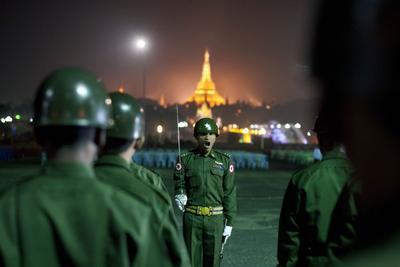Internally, the government abolished the public ban on gatherings of greater than five people and continued the release of political prisoners (with the promise to free all remaining ones by year’s end). The creation by Parliament of a special review committee investigating areas of possible amendments to the much-criticised Constitution was an important acknowledgement that the current political system needs to be modified.
Internationally, the recommencing of loans by the Asian Development Bank after a 30-year hiatus, as well as the removal of remaining sanctions (except for those pertaining to arms sales) by the European Union, were major victories for Naypyidaw in their continued foreign diversification strategy and securing of investment and trade with the West.
In September the government signed the Additional Protocol with the International Atomic Energy Agency easing concerns about the country’s nuclear ambitions.
Additionally, the successful hosting of the 2013 Southeast Asian Games in December was symbolic and an exposure to the logistical and organisational challenges associated with such events.
2013, however, was also defined by events that illuminate the complex and interconnected nature of the challenges threatening to derail democratic progress.
Renewed fighting in Kachin State in January raised concerns about the government’s ability to control their front-line commanders — their bombing campaign in apparent contradiction to the president’s orders. Furthermore, despite government pronouncements stating otherwise, evidence that senior Tatmadaw officials have maintained arms dealing ties with North Korea is another example where the military-backed regime may not have oversight let alone control over the military’s actions. The allotment of large and non-transparent military budgets also continues at the expense of other desperately needed portfolios, such as health and education.
Ethnic tensions, specifically between Buddhists and Muslims, took a troubling turn as violence not only persisted but intensified and spread throughout the country leading to a state of emergency in the town of Meiktila. In particular, the marginalisation of the Rohingya population (who are not even recognised as citizens) primarily in Rakhine State has led to the deaths of hundreds and displaced of over 140,000 in camps.
The ability and willingness of the present government, and the opposition as a potential government in waiting, to move from the military cessation of hostilities to the beginnings of a sustained political dialogue is unclear. Securing ethnic minorities’ involvement and participation in Myanmar’s democratisation project is essential for the state’s stability and prosperity. Ethnic groups are represented in Parliament but many stress the need for central authorities to engage in a country-wide conversation to negotiate matters including: revenue-sharing in their resource rich lands; compensation for past military abuses and land seizures; the maintenance of their armed forces; their degree of political autonomy and possible constitutional change towards a federated state structure.
Continued conflict and strife possess challenges to relations with neighbouring, specifically Muslim, states such as Bangladesh and Malaysia, threatening foreign investment and resource development. Instability is also a potential justification for the military’s perpetual political involvement to ensure the state’s integrity.
Decades-long mistrust held by ethnic groups since the failure to implement the Panglong Agreement of 1947 demonstrates the inaccuracies of depicting the success of Myanmar’s democratic project as solely dependant on the removal of the military from the political apparatus. The development of a multi-ethnic state is necessary and requires a fundamental transformation of not only civilian–military relations but between the majority Burmans — who dominate the military and the major political parties — and the various ethnic groups who comprise over a third of the population.
The current silence and lack of policy formulation by the opposition National League for Democracy (NLD) — who will most likely assume power in 2015 — casts doubt over whether they would resolve such matters expeditiously.
Looking forward, 2014 will be an important year for Myanmar internationally as it assumes the ASEAN chairmanship. Myanmar’s diplomatic skills will be put to the test as it leads the organisation towards further integration amidst growing tensions over maritime boundary disputes and strategic hostilities in relation to the growing power of China and the resultant American ‘pivot’.
The actions of Myanmar’s main political actors in 2014 will be guided in part to position themselves favourably for the 2015 elections. The prospects of constitutional change will be a central theme politically.
The NLD has argued that without real substantive reform the elections will not be free and fair; such widespread change, however, seems unlikely. The creation of a sustained process of gradual constitutional reform is a more palatable avenue for Myanmar’s current power holders whose cooperation is needed. The idea that the removal of the military politically shall be the high water mark of reforms, and that the 2015 election will be the final litmus test of whether Myanmar has been successful in its democracy transition, is unrealistic and parsimonious.
It is hard to conceive, though, how reforms can continue without encroaching on areas that have been carefully cordoned off by the military, considering their impact on the future of Myanmar’s political stability and economic and social development. 2014, therefore, will be defined by the continuation, not the completion, of reforms by a regime cautious about designing a system that may eventually lead to their own downfall.
But the sheer complexity inherent in these reforms appears to be taking a life of its own beyond the intentions or ability to reverse such processes by the original architects without incurring large-scale backlashes internally and externally. While not turning back to military rule, what Myanmar is and what it will become is still uncertain.
Adam P. MacDonald is an independent researcher based in Halifax, Canada.
This article is part of an EAF special feature series on 2013 in review and the year ahead.

